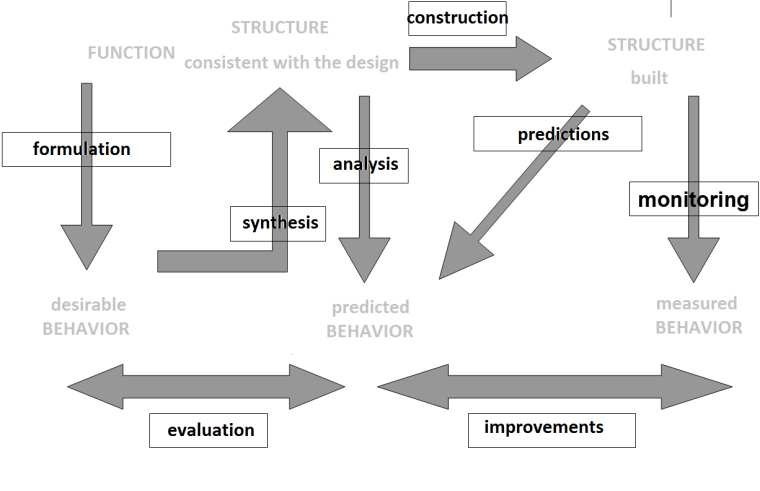Computer Aided Engineering
Construction, like other engineering fields, may be perceived and analysed from the perspective of the process of transforming information. One of the stages of this process is very well known – when we calculate the displacement of a beam, data about the structure (dimensions, material, load etc) is transformed into information about behaviour (such as displacement). Apart from these two types of information, there is also the information about the function of the structure; its design criteria, specifications, social expectations and so on.
Formulation
The first stage in the information transformation process is formulation – transforming information about functions into information about desired behaviours, in accordance with parameters such as safety, durability, stability, appearance and so on.
Synthesis
The second stage is synthesis. The parameters associated with the desired behaviour of the structure and loads are transformed into spatial information about the structure in accordance with the design. An example here is preliminary selection of foundations, as well as the type and size of load-bearing components.
Analysis
The third stage is analysis and assessment. After gathering information concerning the structure, we can analyse it to determine its expected behaviour (response). Most often, this information concerns the internal forces and displacements (deformation) caused by loads. These values are compared with the desired behaviours of the structure.
Many of the calculation methods used to analyse the structures are performed by computers. If the evaluation results are not satisfactory, the synthesis and analysis stages are repeated, or the formulation is changed. This is an iterative process. Designing is an iterative combination of synthesis and analysis, taking into account the formulation.
Construction
The next stage is construction – going from the design, to a built structure.
The last, stage is monitoring the built structure. If there is any uncertainty about the behaviour of the structure, monitoring can provide information about the third type of behaviour of structures – 'measured'. This comparison between the predicted and measured behaviours of a structure may lead to improvements in the structure or in the assessment techniques that have been used.
Image: Information flow in construction ( Original source: B. RAPHAEL, I.F.C. SMITH, Fundamentals of Computer Aided Engineering, Wiley, 2003.)
Computer Aided Engineering (CAE) therefore is the transformation between; information on functions; information on behaviours; and, information on the structure.
The text in this article is based on an extract from COMPUTER METHODS IN CONSTRUCTION, by Christoph Motzko, Florian Binder, Matthias Bergmann, Bogdan Zieliski, Mariusz Zabielski and Robert Gajewski. Darmstadt, Warsaw 2011. The original manual was developed within the scope of the LdV program, project number: 2009-1-PL1-LEO05-05016 entitled “Common Learning Outcomes for European Managers in Construction”. It is reproduced here in a slightly modified form with the kind permission of the Chartered Institute of Building.
[edit] Related articles on Designing Buildings
Featured articles and news
The benefits of engaging with insulation manufacturers
When considering ground floor constructions.
Lighting Industry endorses Blueprint for Electrification
The Lighting Industry Association fully supports the ECA Blueprint as a timely, urgent call to action.
BSRIA Sentinel Clerk of Works Training Case Study
Strengthening expertise to enhance service delivery with integrated cutting-edge industry knowledge.
Impact report from the Supply Chain Sustainability School
Free sustainability skills, training and support delivered to thousands of UK companies to help cut carbon.
The Building Safety Forum at the Installershow 2025
With speakers confirmed for 24 June as part of Building Safety Week.
The UK’s largest air pollution campaign.
Future Homes Standard, now includes solar, but what else?
Will the new standard, due to in the Autumn, go far enough in terms of performance ?
BSRIA Briefing: Cleaner Air, Better tomorrow
A look back at issues relating to inside and outside air quality, discussed during the BSRIA briefing in 2023.
Restoring Abbotsford's hothouse
Bringing the writer Walter Scott's garden to life.
Reflections on the spending review with CIAT.
Retired firefighter cycles world to raise Grenfell funds
Leaving on 14 June 2025 Stephen will raise money for youth and schools through the Grenfell Foundation.
Key points for construction at a glance with industry reactions.
Functionality, visibility and sustainability
The simpler approach to specification.
Architects, architecture, buildings, and inspiration in film
The close ties between makers and the movies, with our long list of suggested viewing.
SELECT three-point plan for action issued to MSPs
Call for Scottish regulation, green skills and recognition of electrotechnical industry as part of a manifesto for Scottish Parliamentary elections.
UCEM becomes the University of the Built Environment
Major milestone in its 106-year history, follows recent merger with London School of Architecture (LSE).
Professional practical experience for Architects in training
The long process to transform the nature of education and professional practical experience in the Architecture profession following recent reports.
A people-first approach to retrofit
Moving away from the destructive paradigm of fabric-first.
New guide for clients launched at Houses of Parliament
'There has never been a more important time for clients to step up and ...ask the right questions'
The impact of recycled slate tiles
Innovation across the decades.
EPC changes for existing buildings
Changes and their context as the new RdSAP methodology comes into use from 15 June.



























